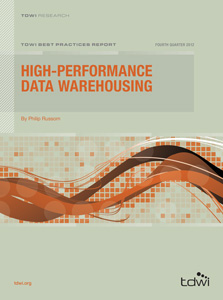
TDWI Best Practices Report | High-Performance Data Warehousing
October 1, 2012
Data used to be just data. Now there’s “big data,” real-time data, multi-structured data, analytic data, and machine data. User communities have swollen into thousands of concurrent users, reports, dashboards, scorecards, and analyses. The rising popularity of advanced analytics has driven up the number of power users with their titanic ad hoc queries and analytic workloads. And there are still brave new worlds to explore, such as social media and sensor data.
The aggressive growth of data and attendant disciplines has piled additional stresses on the performance of systems for business intelligence (BI), data warehousing (DW), data integration (DI), and analytics. That stress, in turn, threatens new business practices that need these systems to handle bigger and faster workloads. Just think about modern analytic practices that depend on real-time data, such as operational BI, streaming analytics, just-in-time inventory, facility monitoring, price optimization, fraud detection, and mobile asset management. Many of the latest practices apply business analytics to leveraging big data, which is a performance double whammy of heavy analytic workloads and extreme scalability.
High-performance data warehousing (HiPer DW) is primarily about achieving speed and scale while also coping with increasing complexity and concurrency. The good news for BI, DW, DI, and analytic practices is that solutions for high performance are available today.
This TDWI Best Practices Report helps users understand new business and technology requirements for high-performance data warehousing (HiPer DW), as well as the many options and solutions available, whether vendor-built or user-built. Of course, performance doesn’t result solely from the data warehouse platform, so this report also discusses analytics, BI, visualization, data integration, clouds, grids, appliances, data services, Hadoop, and other types of tools and platforms.
The tips and strategies presented in this research can help user organizations prioritize their acquisition of vendor tools and their adoption of design best practices for high-performance data warehousing. Download the full, 36-page report to learn more.
Content Provided by
TDWI, IBM, Cloudera, Oracle, ParAccel, SAP, SAS, Teradata, Vertica